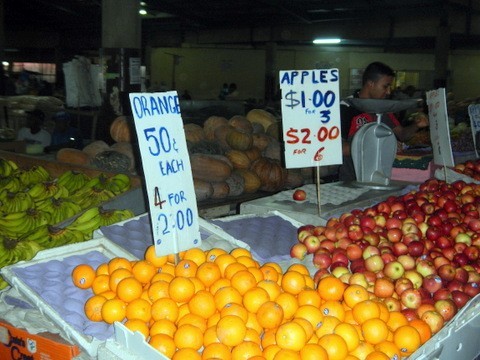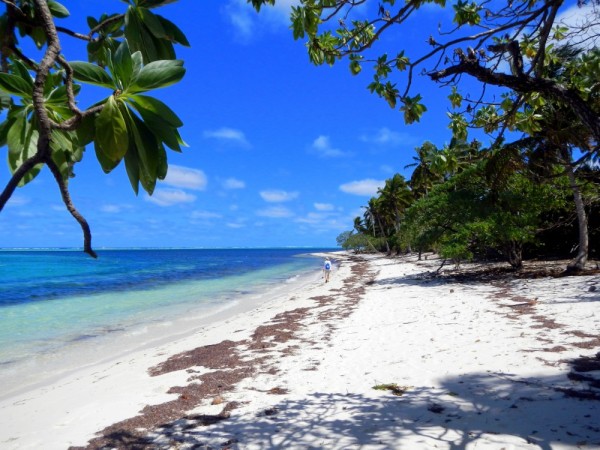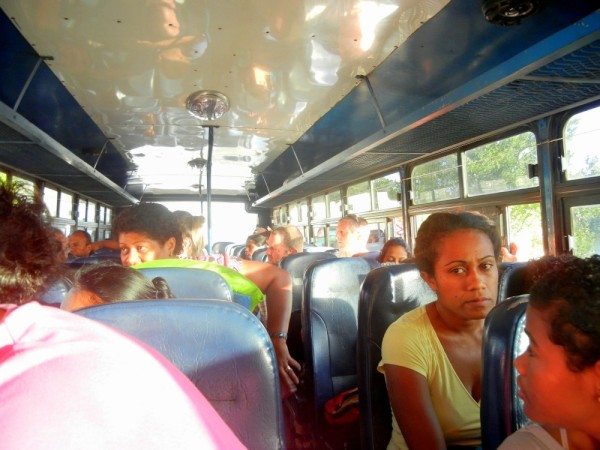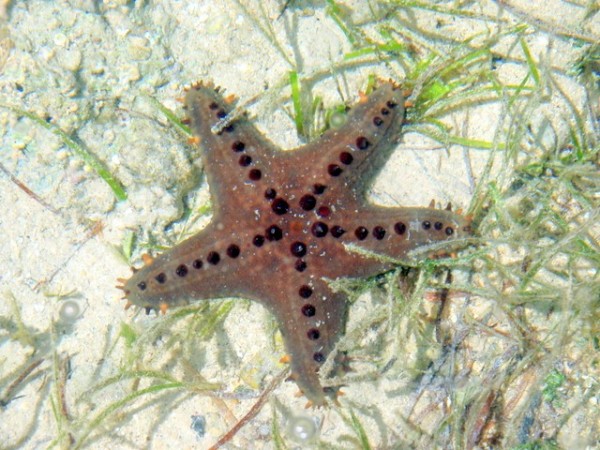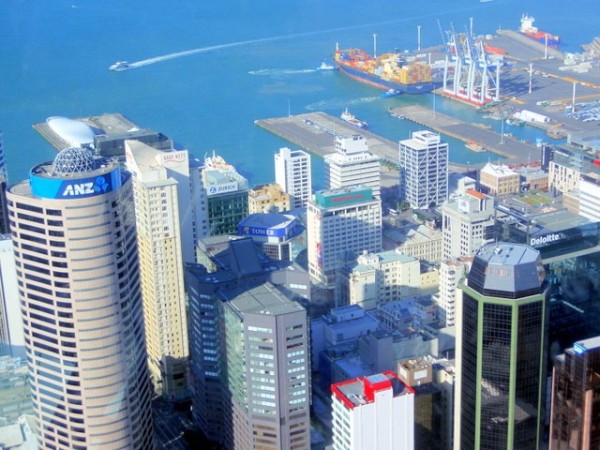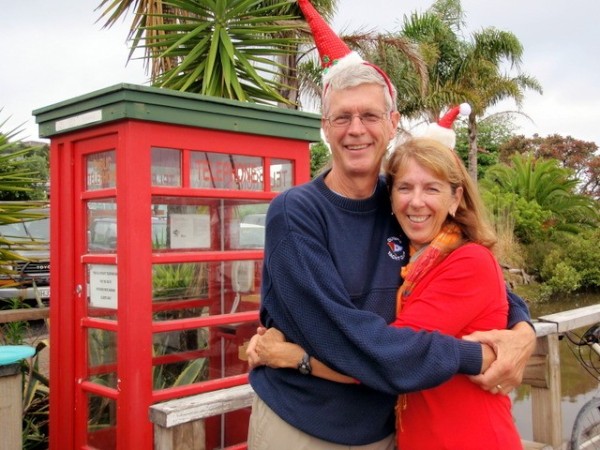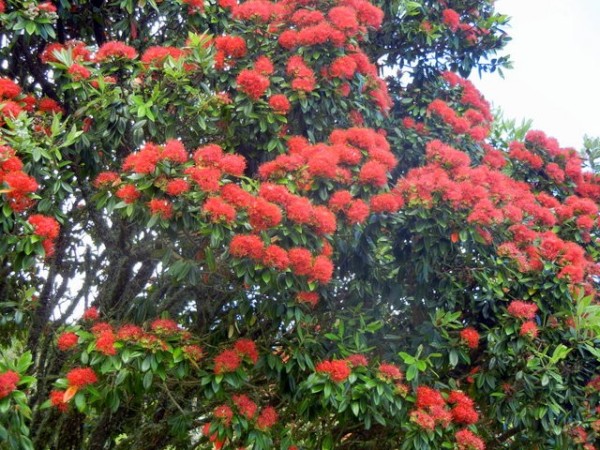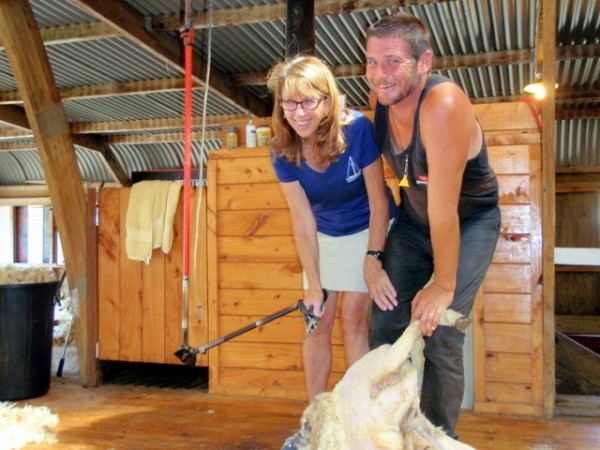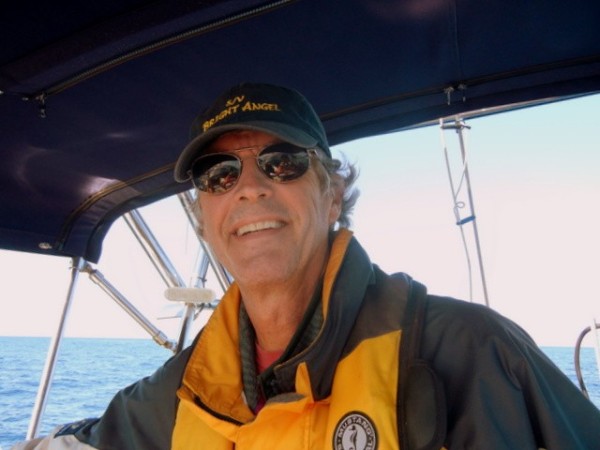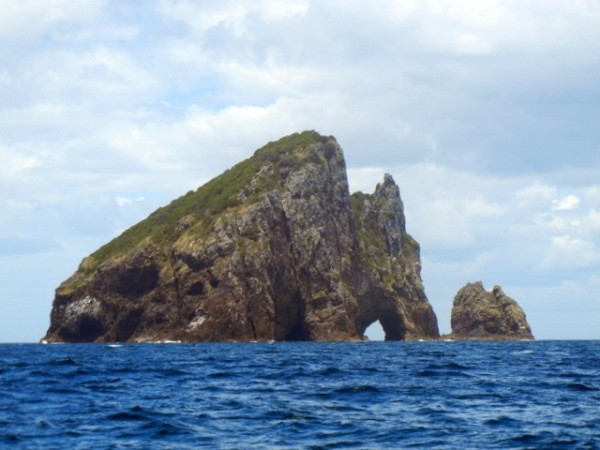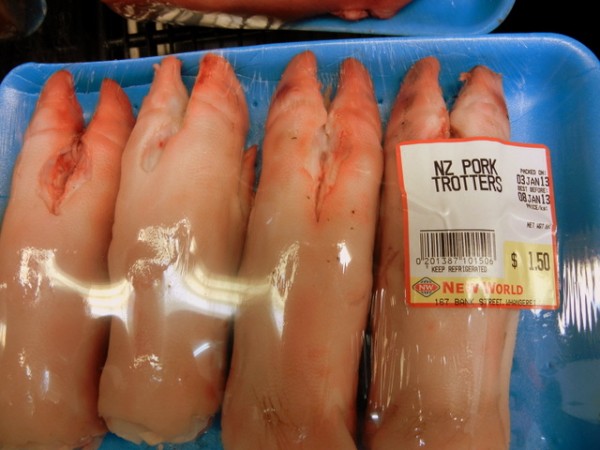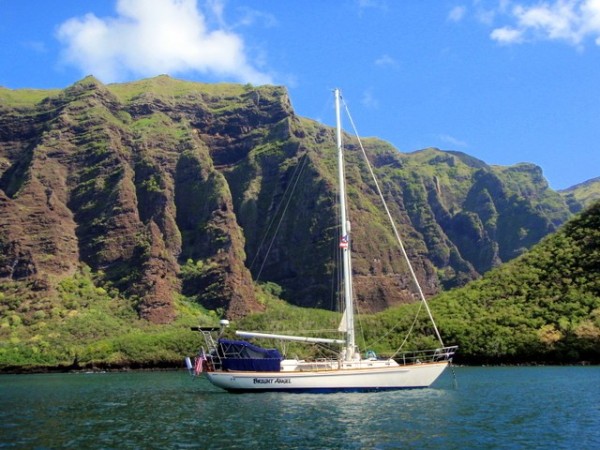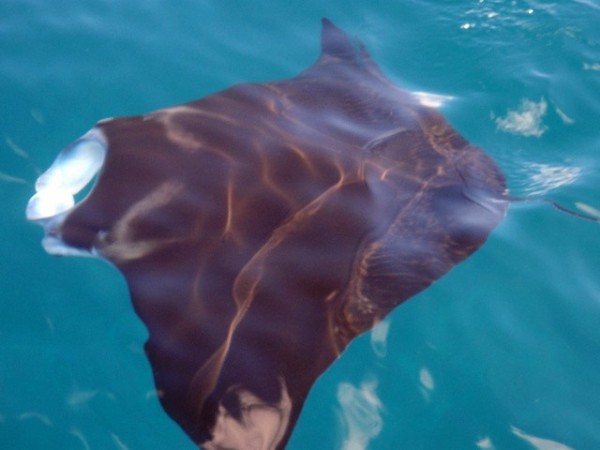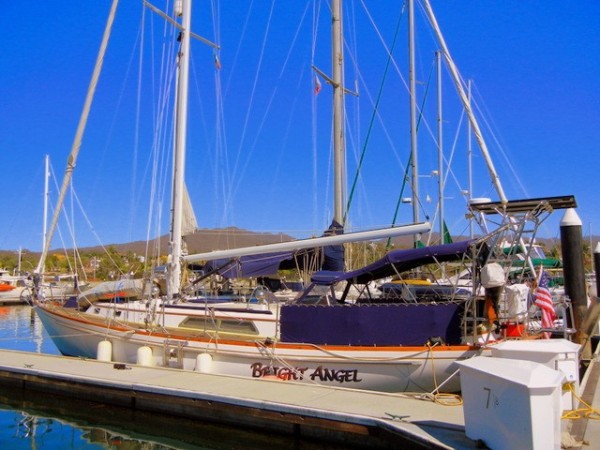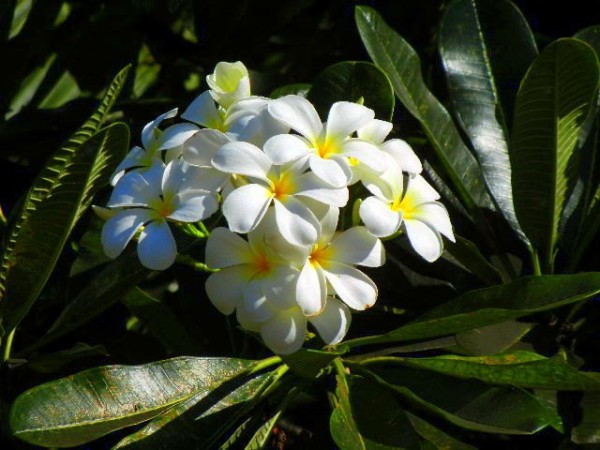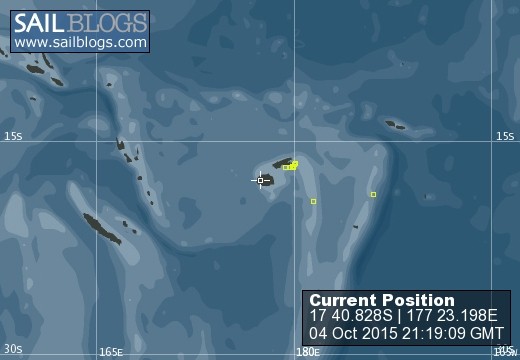
SailBrightAngel
The Adventure Continues
20 October 2013 | Fulanga, Southern Lau Group, Fiji
20 October 2013 | Village of Maunaithaki, Fulanga, Lau Group, Fiji
20 October 2013 | Village of Maunaithaki, Fulanga, Lau Group, Fiji
20 October 2013 | Southern Lau Group, Fiji
29 September 2013
10 August 2013 | Savusavu, Vanua Levu
06 July 2013
06 July 2013
06 July 2013
03 July 2013
02 July 2013
01 July 2013
29 June 2013
24 June 2013
13 November 2012 | Vava'u, Tonga
04 September 2012 | Bora Bora, French Polynesia
31 July 2012 | Uturoa, Raiatea
14 June 2012 | Tiputa, Rangiroa, Tuamotus
TAHITI et ses îles
31 July 2012 | Uturoa, Raiatea
Bob
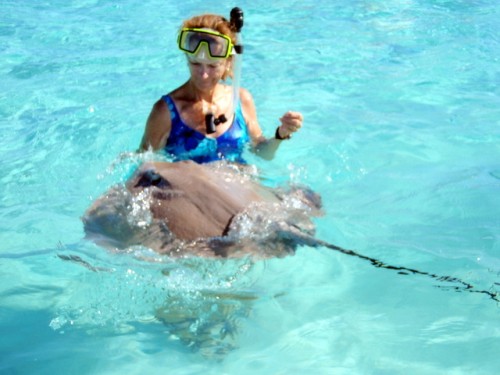
Tahiti et ses îles - "Tahiti and Her Islands" - Tahiti claims as "her islands" all of the archipelagoes of French Polynesia - Tuamotu, Gambier, Marquesa, Austral and Society; but it is in the Societies (in which Tahiti is located) that we have spent our time since our last post. We have visited Tahiti, Mo'orea, Huahine, Taha'a, and Raiatea - where we are now at the town quay in Uturoa, the capital of Raiatea and second largest city in French Polynesia; Bora Bora will be our last stop before leaving French Polynesia in early August.
It would be nice if we could say that we have been enjoying nothing but sunny skies, gentle trade wind sailing, palm fringed beaches on turquoise lagoons, and maitais for breakfast, lunch, and dinner - but, it would not be true, especially about the maitais! To be sure, we have had some wonderful experiences, seen some incredibly beautiful scenery, met new friends and spent quality time with old friends, and generally packed our sea bags with unforgettable memories. But the wind, seas, and the weather in general have often been less than charitable, and many of the anchorages we have been in have been a real challenge, underscoring the fact that the good times come at a price and that if this were easy, everyone with a boat and a dream would be doing it. But is not easy, and it is not always fun; but we are still "living the dream" as they say, and would not have it any other way!
So, where to begin? We'll start with the passage from Rangiroa, in the Tuamotus, to Papeete, Tahiti - two nights at sea in near gale winds and rough seas that made being below decks feel akin to being in a washing machine on the heavy duty cycle, all of which started off with a trip out Tiputa Pass on Rangiroa that still turns my knees to rubber just thinking about it! Timing is everything in negotiating the passes into or out of the atolls in the Tuamotus, and slack water is the key - although you do not always get it, as we discovered. There had been several days of strong winds that pushed large quantities of water over the reefs into the lagoon on the windward, or SE side of the atoll, so there was strong ebb out of Tiputa Pass on the leeward, or NE side of the atoll. We entered the pass almost two hours after low tide, but there was still 3 knots of current ebbing. With sails up, we were motoring at 6 knots, doing 9 knots over the ground. There were waves breaking on the fringing reef outside the pass, which was to be expected, but when we got about half way through the pass, which is about 100 yards wide with reefs on either side, we could see standing waves across the mouth of the pass - probably the result of the outgoing current and large swell running outside from the heavy weather of the past several days. By the time we saw the conditions, it was too late to safely turn the boat around in the pass, so we pressed on. It was a wild up and down ride thru the waves, taking water over the bow, but it was over in a matter of minutes, and then we were outside motoring into the swell to avoid the large slick of turbulent water just beyond the standing waves. When we were clear of all danger, we radioed back to the two other boats that were making the passage with us and advised them to wait a while before coming through the pass; but they had already figured that out from watching us go through! An hour later they still had a rough go of it!
So why were we making this passage in near gale conditions (force 7 winds, 28-33 knots)? Well, we had not planned on it - in fact, we had waited out several days of such weather in Rangiroa, and then waited a couple more days of forecast 15-20 knot winds to let the seas calm down from 3.5 to 2.5 meters (still pretty lumpy!); but, none of the weather forecasting tools do well with squally conditions, and even though the mid-morning to early afternoon conditions were "as advertised" we were in almost constant squalls from early evening throughout the night, with rain and winds constantly in the high 20's, and often gusting over 30 - at one point, we had 30+ knots for several hours straight. Fortunately, we had hanked on our storm staysail (a very strong but small sail set on our inner forestay) before leaving Rangiroa, thinking we would roll up the jib as we neared Tahiti and use the storm staysail to slow us down so as not arrive off Papeete Pass in the dark. However, but for a brief period just after leaving Rangiroa when we sailed with both the jib and the staysail (our first time sailing Bright Angel as a cutter!) we sailed almost entirely with the storm staysail and our usual double reefed main (the Monitor wind vane likes the main set that way). When the winds were in the high 20's and 30's, we were still making 6.5 - 7 knots of boat speed!
Our initial stay in Papeete was quite brief - only a few days. We anchored off Maeva Beach, near Marina Taina, southwest of town. The anchorage was very crowded, there was no room at the marina and all of their mooring balls were full, as was the Quay de Yachts in downtown Papeete; every cruising boat stops in Papeete on the way through French Polynesia to comply with customs and immigration requirements. Papeete Pass was "a piece of cake" - wide, deep, well-marked leading lines, and no need to worry about currents. You do need permission from the Port Director (by calling him on VHF radio) to enter the harbor, and he controls all movements within the busy harbor - a good thing, given all the freighters, cruise ships, high speed ferry boats, mega-yachts, sail boats, and local fishing boats that frequent the harbor. We turned SW after entering the harbor on our way to the anchorage, which took us past the Tahiti airport that is right next to the water; the Port Director calls the airport to see if any large jets are landing or taking off before giving you permission to proceed past either end of the runway. The trip from the harbor to the anchorage was our first time navigating inside a fringing reef- a very strange environment, indeed! On the outside of the reef, which can be as close as a few hundred yards, the surf is pounding in large breaking waves, but inside the reef the water is calm and a beautiful turquoise color (shallow!). The channel you navigate inside the reef is marked by red poles with a square on top (on the island, or shore side) and green poles with a triangle shape on top (on the reef, or ocean side), with occasional black and yellow poles with two triangles on top marking dangerously shallow spots in the channel. The red and green poles are seldom evenly spaced or set in a straight line, as the channel meanders, and it is sometimes hard to see the color of the poles (especially when looking into the sun) so paying attention to the shapes on top is important, because the water can go from a safe 20 feet deep or more to inches in a matter of a few yards - not much room for error! Once we were anchored the scene was almost surreal - calm turquoise water, surf breaking on the reef beyond, and in the distance, the beautiful silhouette of Mo'orea a mere 18 miles away, with the sun setting behind her phenomenal peaks.
We spent our first day in Tahiti resting, catching up with some old friends we had not seen since Mexico, and checking out some of the amenities of civilization ashore - nice restaurants near the marina (with great Happy Hour prices in the bar!), a huge grocery store (their term is "hyperstore") with the most incredible selections of meat (mostly from New Zealand), seafood, produce, cheese, wines (mostly French, but with token Barefoot and Carlo Rossi wines from the US), a fantastic deli, and the ubiquitous fresh baked baguettes (that are very cheap, about 50₵, because they are subsidized). And, just down the street, a McDonald's - right on the beach! Linda had her favorite - a cheese burger with mustard only (the poor clerk was a bit confused - when Linda emphasized "mustard only" the clerk asked "You mean no meat or cheese?" - I guess they don't get that limited condiment request very often!) I ordered one of the local special sandwiches - (you guessed it) a "McBaguette" - hamburger, Swiss cheese, lettuce and grey poupon mustard on a baguette; quite tasty, really - I have had more than one!
On Friday, June 22, we took the bus into Papeete and went to the registration and kick-off party for the Tahiti-Mo'orea Sailing Rendezvous - an event jointly sponsored by Tahiti Tourism and a number of businesses interested in cruising sailors, to include Latitude 38 magazine of San Francisco, sponsors of the Pacific Puddle Jump and Baja Ha-Ha rallies. The Rendezvous is designed to celebrate a successful Pacific crossing, and to welcome the cruisers to French Polynesia. It was a fun evening, complete with traditional Polynesian dancers and drumming, wine tasting (Vin de Tahiti - the grapes are actually grown on Rangiroa, where the winery is also located), and a traditional Polynesian "Blessing of the Fleet."
On Saturday morning there was a "rally" to Mo'orea (actually it was a race, complete with starting and finishing lines and recorded finish times - we finished 16th out of about 35 boats in the "rally"). The anchorage for the event was on a sandbar off a beautiful waterfront park at the mouth of Oponohu Bay - a stunning setting! But the anchorage was overcrowded, to say the least - there were 20 or more Rendezvous participants already there (who did not participate in the race), and maybe another 5 or so boats who were not part of the Rendezvous - 60 or more boats in all in an anchorage that maybe should have only held 35 comfortably. After finding a spot to anchor in 35 feet of water fairly close to the shore side reef, so close to a neighboring boat that we put fenders along our port side, and with only enough swinging room to let out 125 feet of chain (a little over 3½:1 scope - not ideal; more -maybe 5:1- is much better!), we put the dinghy in and rowed ashore for the afternoon cocktail reception; very nice, visiting with old friends and meeting new ones.
That evening the wind came up - with gusts over 30 knots at times - and anxieties (not just mine!) escalated in the anchorage. I decided to risk getting a little too close to the boats anchored behind us, and let out another 50 feet of chain, giving us decent 5:1 scope - and much better holding. When I let out more chain, the boat in front of us did too, as did the closest boat behind us. We were then lying a little further away from the French boat on our port side (not a Rendezvous participant). The winds settled back down, and we were able to finally get some sleep.
The main Rendezvous activities were on Sunday - a fun day with va'a (Polynesian outrigger canoe) races, traditional arts and crafts demonstrations, a traditional Polynesian feast for lunch, and then various traditional sports events, capped off with Polynesian dancing and drumming. It was a long day - when the sun went down, so did the eyelids . . . . until it started raining. At anchor, we sleep in the V-berth, with the overhead hatch and cabin side port lights (windows) open. If it starts raining (yes - it does rain here in paradise - fairly frequently, as a matter of fact!) we just reach up and close the hatch and port lights and go back to sleep. That night, when I awoke to a light sprinkle on my face, we had not gotten the hatch and windows closed before the sprinkle turned into a deluge that sounded like a freight train on the cabin top - a full blown squall was upon us! Linda and I raced out into the cockpit to find the pelting rain coming down almost horizontally, and the wind howling - the noise was deafening! (Another boat behind us with their anemometer on reported seeing peak gusts of 57 knots - that is force 11, or "violent storm"; force 12 is hurricane!) It was a terrifying sight; as best one could see in the rain, boats were swinging back and forth, and some were moving - dragging anchor! I started the engine to motor forward and take the strain off the anchor, but before I could put the boat in gear we were t-boned on our bow by a 50-footer that had come from well forward and to our port side. Linda and I both rushed forward to help the woman on the bow of that boat fend off of our boat - by the time we got there, their boat was sliding back along our port side, and was rolling up the fenders we fortunately still had out. Between the three of us we got the boats separated enough to push the fenders back down, but then I realized they had hit our dinghy that was tied off on our port quarter, and I remember saying "There goes our dinghy." But the dinghy turned out to be okay, except for some damage to the dinghy chaps where the friction of the boat sliding by just burned away the fabric over the dinghy's rub rail. In fact, if the dinghy had not been there, the other boat's cockpit hardware (arch and railings) could easily have taken out our outboard on the stern rail, if not our arch and solar panels: thanks, dink!
I got back on the helm and put the boat in gear, and with Linda "calling traffic" from the side deck, steered to dodge at least two boats that drug past us. By now, the boat that hit us was tangled up (anchor chains) with the French boat off our port side, and I had to veer away to avoid getting caught up with their efforts to get untangled. By now the wind was down, and there were at least four guys in dinghies helping them get untangled. Whew - what a night! We know of at least five boats that drug anchor (we stayed solidly hooked - I can't say enough about our Rocna 40kg; great anchor!), and several (including us) that were damaged in the melee. But thankfully no one lost their boat, and no one was injured. Our bow pulpit and one stanchion was bent, and the base of the bow pulpit was torn out of the deck. We were able to bend the stanchion back, I reattached the pulpit base with the better part of a day's labor, and Linda was able to repair the dinghy chaps with a little over a day's labor. We will likely have the bow pulpit replaced in New Zealand, at some considerable expense - ours, as the guy who hit us refused to take responsibility. You meet some real characters out here, and some with real character flaws. 'Nuff said.
We stayed on in Mo'orea for several more days, as the anchorage cleared out and gave us much more swinging and breathing room. We visited and had dinner with friends, went on a tour of Mo'orea (a breathtakingly beautiful island), and participated in a local ritual: we got in the water with and fed the sting rays off the fringing reef. Yes, you read that right - sting rays; and, these were no little guys - they were easily 4-5 feet across their fins! You stand in chest deep water and hold a scrap of fish in your hand, and the rays will eat right out of your hand. You have to keep your fingers and thumb tucked in, as the ray's eyes are on top of its head, and its mouth is underneath its body - it can't see what it is eating to distinguish your fingers from the offering of fish, and although a ray has no teeth, it can "gum down" pretty hard - don't ask me how I know! Linda had so much fun with the rays - that is why a picture of her feeding a sting ray is featured at the top of this post!
After Mo'orea we went back to Tahiti to make our repairs, do some boat maintenance, fill one of our propane tanks, and visit Papeete - something we did not really get a chance to do when we were last in Tahiti. We took a slip at the Quay de Yachts right in downtown Papeete - convenient, but somewhat noisy; and, when the ferries would come and go, there was a lot of surge at the dock. The quay is a med-moor arrangement; still not my favorite, but not as intimidating as I thought it would be (as long as there are helpers on the dock, that is). You come in perpendicular to the dock, bow or stern in (we went bow in), give your port and starboard dock lines to your helpers to secure to the dock, then pick up a messenger line that is attached to the dock on each side of the boat and walk back, in our case to the stern, pulling the messenger lines up until you come to the end of a heavy line that is attached to the sea bed that you then cleat off on each side of the boat, hauling up tight to keep the bow (or stern) off the dock. To get off the boat, we had to climb out around the bow pulpit, and step off the toe rail or the anchor onto the dock. European boats that routinely med-moor "back home" carry boarding ladders or planks for this purpose - something I guess we'll have to add to our inventory! The quay was equipped with shore power - European flavor (220V, 50hz) - so I got a chance to try out our "international" shore power plug and "smart charger" that does not care whether you feed it 110V, 60hz (North American flavored power) or 220V, 50hz. If we hooked up Euro juice to our regular inverter-charger it would fry the system; but, the smart charger arrangement worked fine, and kept the batteries topped off around the clock-something the solar panels have a tough time doing!
On the whole, Papeete was somewhat disappointing. While you can get just about anything you might need there - there are several good chandleries, and an Ace Hardware store that is almost as big as a Home Depot - the city itself is very tired and rundown. There is brew pub, though, with a few decent beers (a nice change from Hinano - the Budweiser of Polynesia), and a beautiful waterfront park, with an outdoor performing arts auditorium where we watched the opening night of the Heivā i Tahiti dance and singing competition. Heivā is an annual celebration, now in its 130th year, of traditional Polynesian music, dancing, drumming, art and handicrafts, and sports competition. The performances we saw were truly spectacular - we saw three choral groups perform, and two dance groups, each of which had over 100 dancers who performed for well over an hour, went through no less than five elaborate costume changes, and were backed-up by the most vibrant musicians and drummers you could imagine! We also spent the better part of a day viewing the Heivā arts and crafts displays; wonderful wood carvings, shell and bead work, applique, and black pearl jewelry (yes, Linda added to her collection!). From our front row seat at the quay, we watched the start of the va'a races - six man outrigger canoes that race from Papeete, around Mo'orea, and back - a distance of no less than 50 miles that takes over 6 hours to complete. No crew changes are allowed for the first hour; then, changes are at the discretion of the coach. We watched crew change practices one night from the park - it was amazing. The six new crew are dropped off in the water; the canoe is paddled right up to and over them (the new crew is on the outrigger side); the old crew bails out the opposite side while the new crew bails in, and the canoe never stops - it's almost as if they don't miss a beat with the paddles, either! The teams come from all over French Polynesia to compete in Heivā; and those guys are truly buff - quite impressive!
After a week at the quay we went back to Marina Taina and picked up a mooring ball. I had more work to do on the boat: top off the fuel tanks; change the oil in the engine and generator (there was no place to dispose of used oil at the quay, but there is at the marina); and clean the bottom (I was not about to get in the water in Papeete Harbor). Linda also had some provisioning to do at the "hyperstore."
We were ready to leave in a couple of days, but had to wait out a period of strong winds and heavy seas before making the 120 mile overnight passage to Huahine. (Friends of ours who were in nearby Bora Bora at the time reported winds of 40-50 knots in the anchorages!) When the weather forecasts said "all clear" we left - only to relearn an old lesson: weather forecasts cannot be trusted! It was a bumpy, windy (28-30+), wet (breaking waves on the beam that pooped the cockpit too many times to count - we both donned our foul weather gear!) and tiring ride!
When we arrived at Huahine the next morning, the anchorage was windy and crowded - my favorite recipe! We dropped the anchor three times before we found a spot with which we were comfortable. The second time we pulled up the anchor there was a 2x3 foot chunk of (dead) coral hooked on the anchor chain and wedged on the anchor! We hailed friends of ours who were passing by in their dinghy, handed them a hammer, and they broke up the coral so it fell off. That was a new one - thank heavens for a hefty windlass!
We were anchored off the town of Fare, the capital of Huahine, for four days, during which time we walked around the town, enjoyed dinner ashore with friends, shopped in their very well stocked grocery store, read, and generally just relaxed. One day we rented bicycles and rode almost all the way around the larger of the two islands that make up Huahine. We saw some extensive and well preserved ancient Polynesian archeological sites (Huahine has perhaps more preserved archeological sites than any other island in French Polynesia) and stone fish trap systems in an estuary built hundreds of years ago that are still in use today. While we had seen this before, I was struck by the number of homes in the villages we cycled thru that had family cemetery plots right in the front yard. You have to wonder what they do with the dear departed when it's time to move!
After four days of very windy conditions in the anchorage off Fare (it blew in the mid-20's every night) we moved "down island" to a beautiful, uncrowded anchorage at the SW tip of the island where the wind was just a whisper, and the turquoise water was magnificent. We enjoyed happy hour at the local resort's beach bar, and had dinner with friends at a waterfront restaurant that was quite good; it was popular with the locals (always a good sign) who were enjoying an evening of what could best be described as Polynesian karaoke - great entertainment!
With a predicted "wind event" headed our way, we decided it was time to head over to Taha'a and Raiatea, two islands that share a fringing reef that lie 20 miles to the west of Huahine, and find a place to "hunker down." There was no wind to speak of during the crossing, so we motored to Taha'a's Toahotu Pass and headed straight for nearby Haamene Bay, a long, narrow bay on Taha'a's eastern shore, with a village by the same name at the head of the bay, that Charlie's Charts describes as a "hurricane hole." The wind had started to build outside when we started into the bay, but when we reached the village the water was as calm as a mill pond, and we were the only boat there. We anchored in 35 feet of water, with a mud bottom with excellent holding, and enjoyed a peaceful night's sleep.
The next morning, when there was only a slight breeze in the anchorage, we thought it might be fun to put the dinghy in the water and visit the pearl farm in the next bay over. However, we talked by VHF with some friends who were moving down from northern Taha'a to Raiatea who said the winds were gusting to 35 in the passage between the islands, and that we should stay put. We heeded their advice, and within an hour or so the wind started funneling down into our "safe haven" and building until it reached a steady 27-28 knots, with gusts over 30. (Hurricane hole? I guess Charlie had never anchored there in a blow!) I let out more chain, until we had over 7:1 scope. We were officially "hunkered down" in Haamene Bay (for the next four nights) for the duration of the "wind event." These events actually have a name: Mara'umu (in French Polynesia) or Bogi Walu (in Fiji) and are caused by very high pressure systems (usually around 1030mb) to the south that are tracking eastward with strong counterclockwise winds at their leading edge that reinforce the normal trade winds. A mara'umu usually last about a week.
After a few days, when the winds had died down enough to put the outboard on the dinghy and go ashore, we visited the little village of Haamene. We had lunch at a French restaurant on the waterfront (the only other option was a little sandwich shop called "Snack Mac China" that looked a little dubious). The French restaurant, Taha'a Maitai, was a real find! The food was superb. Linda had fresh mahi mahi with vanilla sauce - Taha'a is known for its vanilla -and I had seared fresh tuna brochettes with crusted almonds. For desert - crème brule; and, for a special treat, with my after lunch espresso I had a snifter of 15 year-old calvados (apple brandy). The bill - about $85! Nothing is cheap in French Polynesia; even an unremarkable dinner at a Chinese restaurant with a beer to drink can run $40-50! A couple of shopping bags of groceries can easily top $150!
When we could finally poke out of Haamene Bay without getting blown sideways we ventured over to the west side of the island, and anchored in Tapuamu Bay, another of Charlie's "hurricane holes" where he said "anchorage can be taken in 10 fathoms" (60 feet). The only place where we found 60 feet shoaled to less than 15 feet in a heartbeat! We ended up anchoring in 80 feet in the middle of the bay (where there was adequate swinging room to avoid the shoals) but with all 300 feet of our chain out the scope was just over a minimal 3:1 -and, you guessed it - the wind blew down the valley at the head of the bay, hitting near 25 knots. Then the wind would stop altogether, the boat would drift around on its chain, and the wind would fill in from a different direction (williwaws) - not good with a short scope and the anchor set in sand. It was another restless night at anchor!
Our plan was to spend the next day snorkeling at the "coral gardens" off the fringing reef just outside Tapuamu Bay, but we decided to forego another fun night at anchor in Tapuamu and head straight for Raiatea, where we side tied to the public quay in downtown Uturoa, the capital of Raiatea (and second largest city in French Polynesia) and have enjoyed several peaceful nights. Peaceful, that is, after the drumming and dance practice in the public square across the street lets up at around 9:30 pm. But what fun to watch - young and old alike participate in the dancing, and the drumming is awesome. And this is authentic - not for the tourists!
There are some great supermarkets right across the street from the quay, so Linda has been busy provisioning the boat. We have a long 1275 nautical mile (1476 statue mile) passage to Tonga coming up soon. After about a week in Bora Bora we plan to leave French Polynesia for the Cook Islands and Tonga, on or about August 8. We are planning stops at Palmerston atoll (Cook Islands) and Niue (the world's smallest independent nation) enroute to Tonga, but weather conditions may preclude stopping.
Well, that's it for now. Please check back later for further reports on what we can always hope will be more of the good than the bad and the ugly. Enjoy wherever you are!
It would be nice if we could say that we have been enjoying nothing but sunny skies, gentle trade wind sailing, palm fringed beaches on turquoise lagoons, and maitais for breakfast, lunch, and dinner - but, it would not be true, especially about the maitais! To be sure, we have had some wonderful experiences, seen some incredibly beautiful scenery, met new friends and spent quality time with old friends, and generally packed our sea bags with unforgettable memories. But the wind, seas, and the weather in general have often been less than charitable, and many of the anchorages we have been in have been a real challenge, underscoring the fact that the good times come at a price and that if this were easy, everyone with a boat and a dream would be doing it. But is not easy, and it is not always fun; but we are still "living the dream" as they say, and would not have it any other way!
So, where to begin? We'll start with the passage from Rangiroa, in the Tuamotus, to Papeete, Tahiti - two nights at sea in near gale winds and rough seas that made being below decks feel akin to being in a washing machine on the heavy duty cycle, all of which started off with a trip out Tiputa Pass on Rangiroa that still turns my knees to rubber just thinking about it! Timing is everything in negotiating the passes into or out of the atolls in the Tuamotus, and slack water is the key - although you do not always get it, as we discovered. There had been several days of strong winds that pushed large quantities of water over the reefs into the lagoon on the windward, or SE side of the atoll, so there was strong ebb out of Tiputa Pass on the leeward, or NE side of the atoll. We entered the pass almost two hours after low tide, but there was still 3 knots of current ebbing. With sails up, we were motoring at 6 knots, doing 9 knots over the ground. There were waves breaking on the fringing reef outside the pass, which was to be expected, but when we got about half way through the pass, which is about 100 yards wide with reefs on either side, we could see standing waves across the mouth of the pass - probably the result of the outgoing current and large swell running outside from the heavy weather of the past several days. By the time we saw the conditions, it was too late to safely turn the boat around in the pass, so we pressed on. It was a wild up and down ride thru the waves, taking water over the bow, but it was over in a matter of minutes, and then we were outside motoring into the swell to avoid the large slick of turbulent water just beyond the standing waves. When we were clear of all danger, we radioed back to the two other boats that were making the passage with us and advised them to wait a while before coming through the pass; but they had already figured that out from watching us go through! An hour later they still had a rough go of it!
So why were we making this passage in near gale conditions (force 7 winds, 28-33 knots)? Well, we had not planned on it - in fact, we had waited out several days of such weather in Rangiroa, and then waited a couple more days of forecast 15-20 knot winds to let the seas calm down from 3.5 to 2.5 meters (still pretty lumpy!); but, none of the weather forecasting tools do well with squally conditions, and even though the mid-morning to early afternoon conditions were "as advertised" we were in almost constant squalls from early evening throughout the night, with rain and winds constantly in the high 20's, and often gusting over 30 - at one point, we had 30+ knots for several hours straight. Fortunately, we had hanked on our storm staysail (a very strong but small sail set on our inner forestay) before leaving Rangiroa, thinking we would roll up the jib as we neared Tahiti and use the storm staysail to slow us down so as not arrive off Papeete Pass in the dark. However, but for a brief period just after leaving Rangiroa when we sailed with both the jib and the staysail (our first time sailing Bright Angel as a cutter!) we sailed almost entirely with the storm staysail and our usual double reefed main (the Monitor wind vane likes the main set that way). When the winds were in the high 20's and 30's, we were still making 6.5 - 7 knots of boat speed!
Our initial stay in Papeete was quite brief - only a few days. We anchored off Maeva Beach, near Marina Taina, southwest of town. The anchorage was very crowded, there was no room at the marina and all of their mooring balls were full, as was the Quay de Yachts in downtown Papeete; every cruising boat stops in Papeete on the way through French Polynesia to comply with customs and immigration requirements. Papeete Pass was "a piece of cake" - wide, deep, well-marked leading lines, and no need to worry about currents. You do need permission from the Port Director (by calling him on VHF radio) to enter the harbor, and he controls all movements within the busy harbor - a good thing, given all the freighters, cruise ships, high speed ferry boats, mega-yachts, sail boats, and local fishing boats that frequent the harbor. We turned SW after entering the harbor on our way to the anchorage, which took us past the Tahiti airport that is right next to the water; the Port Director calls the airport to see if any large jets are landing or taking off before giving you permission to proceed past either end of the runway. The trip from the harbor to the anchorage was our first time navigating inside a fringing reef- a very strange environment, indeed! On the outside of the reef, which can be as close as a few hundred yards, the surf is pounding in large breaking waves, but inside the reef the water is calm and a beautiful turquoise color (shallow!). The channel you navigate inside the reef is marked by red poles with a square on top (on the island, or shore side) and green poles with a triangle shape on top (on the reef, or ocean side), with occasional black and yellow poles with two triangles on top marking dangerously shallow spots in the channel. The red and green poles are seldom evenly spaced or set in a straight line, as the channel meanders, and it is sometimes hard to see the color of the poles (especially when looking into the sun) so paying attention to the shapes on top is important, because the water can go from a safe 20 feet deep or more to inches in a matter of a few yards - not much room for error! Once we were anchored the scene was almost surreal - calm turquoise water, surf breaking on the reef beyond, and in the distance, the beautiful silhouette of Mo'orea a mere 18 miles away, with the sun setting behind her phenomenal peaks.
We spent our first day in Tahiti resting, catching up with some old friends we had not seen since Mexico, and checking out some of the amenities of civilization ashore - nice restaurants near the marina (with great Happy Hour prices in the bar!), a huge grocery store (their term is "hyperstore") with the most incredible selections of meat (mostly from New Zealand), seafood, produce, cheese, wines (mostly French, but with token Barefoot and Carlo Rossi wines from the US), a fantastic deli, and the ubiquitous fresh baked baguettes (that are very cheap, about 50₵, because they are subsidized). And, just down the street, a McDonald's - right on the beach! Linda had her favorite - a cheese burger with mustard only (the poor clerk was a bit confused - when Linda emphasized "mustard only" the clerk asked "You mean no meat or cheese?" - I guess they don't get that limited condiment request very often!) I ordered one of the local special sandwiches - (you guessed it) a "McBaguette" - hamburger, Swiss cheese, lettuce and grey poupon mustard on a baguette; quite tasty, really - I have had more than one!
On Friday, June 22, we took the bus into Papeete and went to the registration and kick-off party for the Tahiti-Mo'orea Sailing Rendezvous - an event jointly sponsored by Tahiti Tourism and a number of businesses interested in cruising sailors, to include Latitude 38 magazine of San Francisco, sponsors of the Pacific Puddle Jump and Baja Ha-Ha rallies. The Rendezvous is designed to celebrate a successful Pacific crossing, and to welcome the cruisers to French Polynesia. It was a fun evening, complete with traditional Polynesian dancers and drumming, wine tasting (Vin de Tahiti - the grapes are actually grown on Rangiroa, where the winery is also located), and a traditional Polynesian "Blessing of the Fleet."
On Saturday morning there was a "rally" to Mo'orea (actually it was a race, complete with starting and finishing lines and recorded finish times - we finished 16th out of about 35 boats in the "rally"). The anchorage for the event was on a sandbar off a beautiful waterfront park at the mouth of Oponohu Bay - a stunning setting! But the anchorage was overcrowded, to say the least - there were 20 or more Rendezvous participants already there (who did not participate in the race), and maybe another 5 or so boats who were not part of the Rendezvous - 60 or more boats in all in an anchorage that maybe should have only held 35 comfortably. After finding a spot to anchor in 35 feet of water fairly close to the shore side reef, so close to a neighboring boat that we put fenders along our port side, and with only enough swinging room to let out 125 feet of chain (a little over 3½:1 scope - not ideal; more -maybe 5:1- is much better!), we put the dinghy in and rowed ashore for the afternoon cocktail reception; very nice, visiting with old friends and meeting new ones.
That evening the wind came up - with gusts over 30 knots at times - and anxieties (not just mine!) escalated in the anchorage. I decided to risk getting a little too close to the boats anchored behind us, and let out another 50 feet of chain, giving us decent 5:1 scope - and much better holding. When I let out more chain, the boat in front of us did too, as did the closest boat behind us. We were then lying a little further away from the French boat on our port side (not a Rendezvous participant). The winds settled back down, and we were able to finally get some sleep.
The main Rendezvous activities were on Sunday - a fun day with va'a (Polynesian outrigger canoe) races, traditional arts and crafts demonstrations, a traditional Polynesian feast for lunch, and then various traditional sports events, capped off with Polynesian dancing and drumming. It was a long day - when the sun went down, so did the eyelids . . . . until it started raining. At anchor, we sleep in the V-berth, with the overhead hatch and cabin side port lights (windows) open. If it starts raining (yes - it does rain here in paradise - fairly frequently, as a matter of fact!) we just reach up and close the hatch and port lights and go back to sleep. That night, when I awoke to a light sprinkle on my face, we had not gotten the hatch and windows closed before the sprinkle turned into a deluge that sounded like a freight train on the cabin top - a full blown squall was upon us! Linda and I raced out into the cockpit to find the pelting rain coming down almost horizontally, and the wind howling - the noise was deafening! (Another boat behind us with their anemometer on reported seeing peak gusts of 57 knots - that is force 11, or "violent storm"; force 12 is hurricane!) It was a terrifying sight; as best one could see in the rain, boats were swinging back and forth, and some were moving - dragging anchor! I started the engine to motor forward and take the strain off the anchor, but before I could put the boat in gear we were t-boned on our bow by a 50-footer that had come from well forward and to our port side. Linda and I both rushed forward to help the woman on the bow of that boat fend off of our boat - by the time we got there, their boat was sliding back along our port side, and was rolling up the fenders we fortunately still had out. Between the three of us we got the boats separated enough to push the fenders back down, but then I realized they had hit our dinghy that was tied off on our port quarter, and I remember saying "There goes our dinghy." But the dinghy turned out to be okay, except for some damage to the dinghy chaps where the friction of the boat sliding by just burned away the fabric over the dinghy's rub rail. In fact, if the dinghy had not been there, the other boat's cockpit hardware (arch and railings) could easily have taken out our outboard on the stern rail, if not our arch and solar panels: thanks, dink!
I got back on the helm and put the boat in gear, and with Linda "calling traffic" from the side deck, steered to dodge at least two boats that drug past us. By now, the boat that hit us was tangled up (anchor chains) with the French boat off our port side, and I had to veer away to avoid getting caught up with their efforts to get untangled. By now the wind was down, and there were at least four guys in dinghies helping them get untangled. Whew - what a night! We know of at least five boats that drug anchor (we stayed solidly hooked - I can't say enough about our Rocna 40kg; great anchor!), and several (including us) that were damaged in the melee. But thankfully no one lost their boat, and no one was injured. Our bow pulpit and one stanchion was bent, and the base of the bow pulpit was torn out of the deck. We were able to bend the stanchion back, I reattached the pulpit base with the better part of a day's labor, and Linda was able to repair the dinghy chaps with a little over a day's labor. We will likely have the bow pulpit replaced in New Zealand, at some considerable expense - ours, as the guy who hit us refused to take responsibility. You meet some real characters out here, and some with real character flaws. 'Nuff said.
We stayed on in Mo'orea for several more days, as the anchorage cleared out and gave us much more swinging and breathing room. We visited and had dinner with friends, went on a tour of Mo'orea (a breathtakingly beautiful island), and participated in a local ritual: we got in the water with and fed the sting rays off the fringing reef. Yes, you read that right - sting rays; and, these were no little guys - they were easily 4-5 feet across their fins! You stand in chest deep water and hold a scrap of fish in your hand, and the rays will eat right out of your hand. You have to keep your fingers and thumb tucked in, as the ray's eyes are on top of its head, and its mouth is underneath its body - it can't see what it is eating to distinguish your fingers from the offering of fish, and although a ray has no teeth, it can "gum down" pretty hard - don't ask me how I know! Linda had so much fun with the rays - that is why a picture of her feeding a sting ray is featured at the top of this post!
After Mo'orea we went back to Tahiti to make our repairs, do some boat maintenance, fill one of our propane tanks, and visit Papeete - something we did not really get a chance to do when we were last in Tahiti. We took a slip at the Quay de Yachts right in downtown Papeete - convenient, but somewhat noisy; and, when the ferries would come and go, there was a lot of surge at the dock. The quay is a med-moor arrangement; still not my favorite, but not as intimidating as I thought it would be (as long as there are helpers on the dock, that is). You come in perpendicular to the dock, bow or stern in (we went bow in), give your port and starboard dock lines to your helpers to secure to the dock, then pick up a messenger line that is attached to the dock on each side of the boat and walk back, in our case to the stern, pulling the messenger lines up until you come to the end of a heavy line that is attached to the sea bed that you then cleat off on each side of the boat, hauling up tight to keep the bow (or stern) off the dock. To get off the boat, we had to climb out around the bow pulpit, and step off the toe rail or the anchor onto the dock. European boats that routinely med-moor "back home" carry boarding ladders or planks for this purpose - something I guess we'll have to add to our inventory! The quay was equipped with shore power - European flavor (220V, 50hz) - so I got a chance to try out our "international" shore power plug and "smart charger" that does not care whether you feed it 110V, 60hz (North American flavored power) or 220V, 50hz. If we hooked up Euro juice to our regular inverter-charger it would fry the system; but, the smart charger arrangement worked fine, and kept the batteries topped off around the clock-something the solar panels have a tough time doing!
On the whole, Papeete was somewhat disappointing. While you can get just about anything you might need there - there are several good chandleries, and an Ace Hardware store that is almost as big as a Home Depot - the city itself is very tired and rundown. There is brew pub, though, with a few decent beers (a nice change from Hinano - the Budweiser of Polynesia), and a beautiful waterfront park, with an outdoor performing arts auditorium where we watched the opening night of the Heivā i Tahiti dance and singing competition. Heivā is an annual celebration, now in its 130th year, of traditional Polynesian music, dancing, drumming, art and handicrafts, and sports competition. The performances we saw were truly spectacular - we saw three choral groups perform, and two dance groups, each of which had over 100 dancers who performed for well over an hour, went through no less than five elaborate costume changes, and were backed-up by the most vibrant musicians and drummers you could imagine! We also spent the better part of a day viewing the Heivā arts and crafts displays; wonderful wood carvings, shell and bead work, applique, and black pearl jewelry (yes, Linda added to her collection!). From our front row seat at the quay, we watched the start of the va'a races - six man outrigger canoes that race from Papeete, around Mo'orea, and back - a distance of no less than 50 miles that takes over 6 hours to complete. No crew changes are allowed for the first hour; then, changes are at the discretion of the coach. We watched crew change practices one night from the park - it was amazing. The six new crew are dropped off in the water; the canoe is paddled right up to and over them (the new crew is on the outrigger side); the old crew bails out the opposite side while the new crew bails in, and the canoe never stops - it's almost as if they don't miss a beat with the paddles, either! The teams come from all over French Polynesia to compete in Heivā; and those guys are truly buff - quite impressive!
After a week at the quay we went back to Marina Taina and picked up a mooring ball. I had more work to do on the boat: top off the fuel tanks; change the oil in the engine and generator (there was no place to dispose of used oil at the quay, but there is at the marina); and clean the bottom (I was not about to get in the water in Papeete Harbor). Linda also had some provisioning to do at the "hyperstore."
We were ready to leave in a couple of days, but had to wait out a period of strong winds and heavy seas before making the 120 mile overnight passage to Huahine. (Friends of ours who were in nearby Bora Bora at the time reported winds of 40-50 knots in the anchorages!) When the weather forecasts said "all clear" we left - only to relearn an old lesson: weather forecasts cannot be trusted! It was a bumpy, windy (28-30+), wet (breaking waves on the beam that pooped the cockpit too many times to count - we both donned our foul weather gear!) and tiring ride!
When we arrived at Huahine the next morning, the anchorage was windy and crowded - my favorite recipe! We dropped the anchor three times before we found a spot with which we were comfortable. The second time we pulled up the anchor there was a 2x3 foot chunk of (dead) coral hooked on the anchor chain and wedged on the anchor! We hailed friends of ours who were passing by in their dinghy, handed them a hammer, and they broke up the coral so it fell off. That was a new one - thank heavens for a hefty windlass!
We were anchored off the town of Fare, the capital of Huahine, for four days, during which time we walked around the town, enjoyed dinner ashore with friends, shopped in their very well stocked grocery store, read, and generally just relaxed. One day we rented bicycles and rode almost all the way around the larger of the two islands that make up Huahine. We saw some extensive and well preserved ancient Polynesian archeological sites (Huahine has perhaps more preserved archeological sites than any other island in French Polynesia) and stone fish trap systems in an estuary built hundreds of years ago that are still in use today. While we had seen this before, I was struck by the number of homes in the villages we cycled thru that had family cemetery plots right in the front yard. You have to wonder what they do with the dear departed when it's time to move!
After four days of very windy conditions in the anchorage off Fare (it blew in the mid-20's every night) we moved "down island" to a beautiful, uncrowded anchorage at the SW tip of the island where the wind was just a whisper, and the turquoise water was magnificent. We enjoyed happy hour at the local resort's beach bar, and had dinner with friends at a waterfront restaurant that was quite good; it was popular with the locals (always a good sign) who were enjoying an evening of what could best be described as Polynesian karaoke - great entertainment!
With a predicted "wind event" headed our way, we decided it was time to head over to Taha'a and Raiatea, two islands that share a fringing reef that lie 20 miles to the west of Huahine, and find a place to "hunker down." There was no wind to speak of during the crossing, so we motored to Taha'a's Toahotu Pass and headed straight for nearby Haamene Bay, a long, narrow bay on Taha'a's eastern shore, with a village by the same name at the head of the bay, that Charlie's Charts describes as a "hurricane hole." The wind had started to build outside when we started into the bay, but when we reached the village the water was as calm as a mill pond, and we were the only boat there. We anchored in 35 feet of water, with a mud bottom with excellent holding, and enjoyed a peaceful night's sleep.
The next morning, when there was only a slight breeze in the anchorage, we thought it might be fun to put the dinghy in the water and visit the pearl farm in the next bay over. However, we talked by VHF with some friends who were moving down from northern Taha'a to Raiatea who said the winds were gusting to 35 in the passage between the islands, and that we should stay put. We heeded their advice, and within an hour or so the wind started funneling down into our "safe haven" and building until it reached a steady 27-28 knots, with gusts over 30. (Hurricane hole? I guess Charlie had never anchored there in a blow!) I let out more chain, until we had over 7:1 scope. We were officially "hunkered down" in Haamene Bay (for the next four nights) for the duration of the "wind event." These events actually have a name: Mara'umu (in French Polynesia) or Bogi Walu (in Fiji) and are caused by very high pressure systems (usually around 1030mb) to the south that are tracking eastward with strong counterclockwise winds at their leading edge that reinforce the normal trade winds. A mara'umu usually last about a week.
After a few days, when the winds had died down enough to put the outboard on the dinghy and go ashore, we visited the little village of Haamene. We had lunch at a French restaurant on the waterfront (the only other option was a little sandwich shop called "Snack Mac China" that looked a little dubious). The French restaurant, Taha'a Maitai, was a real find! The food was superb. Linda had fresh mahi mahi with vanilla sauce - Taha'a is known for its vanilla -and I had seared fresh tuna brochettes with crusted almonds. For desert - crème brule; and, for a special treat, with my after lunch espresso I had a snifter of 15 year-old calvados (apple brandy). The bill - about $85! Nothing is cheap in French Polynesia; even an unremarkable dinner at a Chinese restaurant with a beer to drink can run $40-50! A couple of shopping bags of groceries can easily top $150!
When we could finally poke out of Haamene Bay without getting blown sideways we ventured over to the west side of the island, and anchored in Tapuamu Bay, another of Charlie's "hurricane holes" where he said "anchorage can be taken in 10 fathoms" (60 feet). The only place where we found 60 feet shoaled to less than 15 feet in a heartbeat! We ended up anchoring in 80 feet in the middle of the bay (where there was adequate swinging room to avoid the shoals) but with all 300 feet of our chain out the scope was just over a minimal 3:1 -and, you guessed it - the wind blew down the valley at the head of the bay, hitting near 25 knots. Then the wind would stop altogether, the boat would drift around on its chain, and the wind would fill in from a different direction (williwaws) - not good with a short scope and the anchor set in sand. It was another restless night at anchor!
Our plan was to spend the next day snorkeling at the "coral gardens" off the fringing reef just outside Tapuamu Bay, but we decided to forego another fun night at anchor in Tapuamu and head straight for Raiatea, where we side tied to the public quay in downtown Uturoa, the capital of Raiatea (and second largest city in French Polynesia) and have enjoyed several peaceful nights. Peaceful, that is, after the drumming and dance practice in the public square across the street lets up at around 9:30 pm. But what fun to watch - young and old alike participate in the dancing, and the drumming is awesome. And this is authentic - not for the tourists!
There are some great supermarkets right across the street from the quay, so Linda has been busy provisioning the boat. We have a long 1275 nautical mile (1476 statue mile) passage to Tonga coming up soon. After about a week in Bora Bora we plan to leave French Polynesia for the Cook Islands and Tonga, on or about August 8. We are planning stops at Palmerston atoll (Cook Islands) and Niue (the world's smallest independent nation) enroute to Tonga, but weather conditions may preclude stopping.
Well, that's it for now. Please check back later for further reports on what we can always hope will be more of the good than the bad and the ugly. Enjoy wherever you are!
Comments
| Vessel Name: | Bright Angel |
| Vessel Make/Model: | 1990 Mason 44 Hull # 141 |
| Hailing Port: | Olympia, WA |
| Crew: | Linda & Bob Hargreaves |
| About: | |
| Extra: |
Bright Angel's Photos - Main
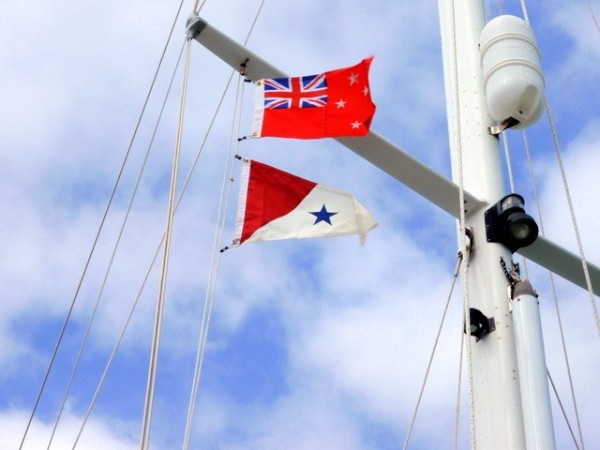 |
Our first stop, where we cleared into New Zealand, was Opua. Before moving south to Whangarei we visited some of the local sights.
17 Photos
Created 25 June 2013
|
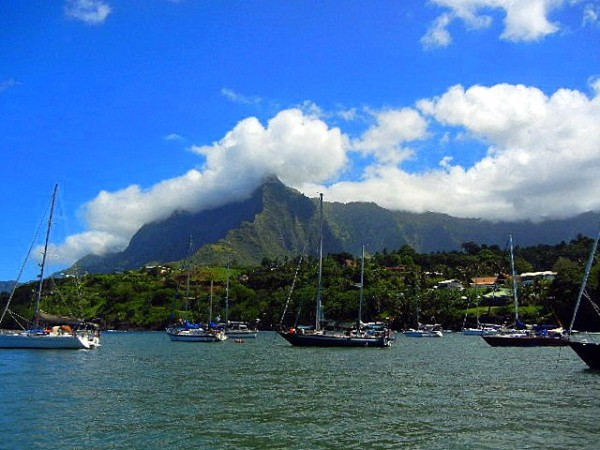 |
Hiva Oa was our first "Landfall in Paradise" after leaving Mexico, and our introduction to life in the islands of French Polynesia.
14 Photos
Created 6 August 2012
|
Sail Bright Angel
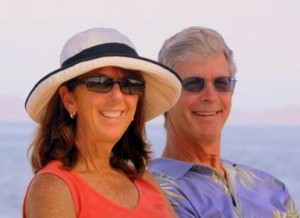
Who: Linda & Bob Hargreaves
Port: Olympia, WA
Current Position
Favorite Links
- John & Lisa on SV Orcinius
- Bill & Cat on SV Island Bound
- Bob & Ann on SV Charisma
- Chris & Rani on SV Ladybug
- Craig & Bruce on SV Gato Go
- Jon & Carol on SV Arnamentia
- Jon & Heather on SV Evergreen
- Ken & Beth on SV Eagles Wings
- Mark & Anne on SV Blue Rodeo
- Pat & John on SV The Rose
- Rich & Cyndi on SV Legacy
- Sail Bright Angel
